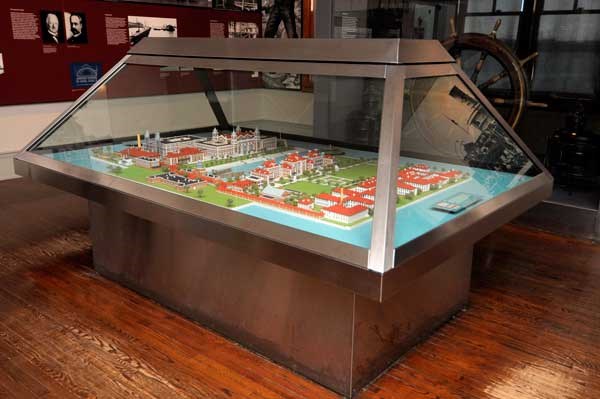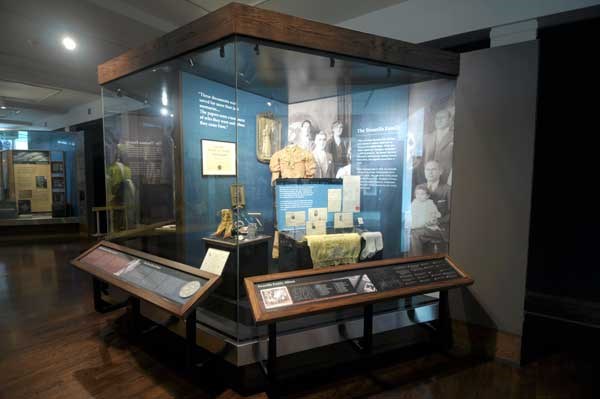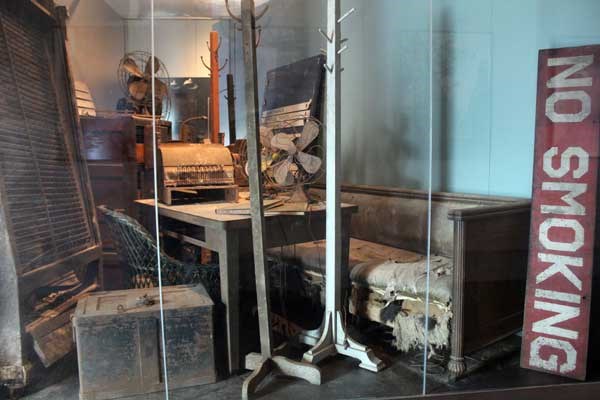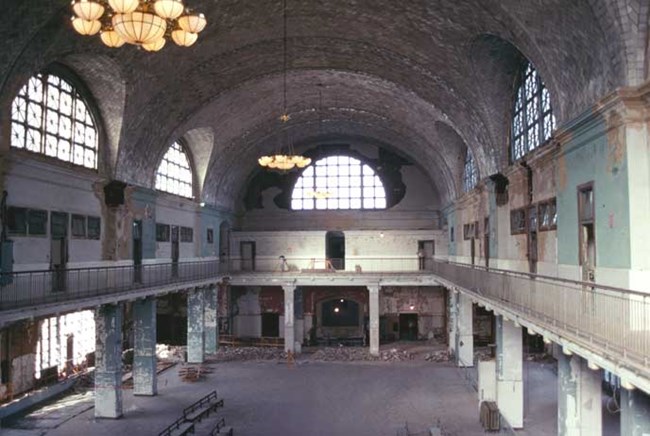|
Dormitory Room 
Statue of Liberty NM, National Park Service. Ellis Island's numerous dormitories were filled to capacity nearly every night with immigrants who were being temporarily detained. Many immigrants stayed in large dormitory rooms located here, along these balconies. From 1900 to 1908, the dormitories consisted of two long, narrow rooms, one on either side of the balcony. Each room accommodated about 300 detainees, who slept in triple-tiered bunk beds that could be raised, thus converting the dormitory into a daytime waiting area. At night, immigrants received blankets to spread over their canvas or wire-mesh "mattresses." This room has been restored to its appearance in 1908, when the two balcony dormitories were refurbished and subdivided into 14 rooms. 
Statue of Liberty NM, National Park Service. Ellis Island Chronicles 
Statue of Liberty NM, National Park Service. "Ellis Island Chronicles," located in the east wing on the third floor of the museum, relates the history of Ellis Island. It describes the island's expansion from an uninhabited 3.3-acre sand bank to a 27.5-acre complex of brick and stone buildings that served as the United States' principal gateway for over three tumultuous decades. During America's peak years of immigration, business was never "as usual" on Ellis Island. Each period brought serious new crises that excited sensational publicity and reflected shifting national opinions that tested and ultimately redefined the immigration policy of the United States. 
Statue of Liberty NM, National Park Service. Treasures From Home 
Statue of Liberty NM, National Park Service. The generosity of America's immigrants and their children created this exhibit, a collection of artifacts donated to the National Park Service by families who came to the United States during the peak immigration years of the late 19th and early 20th centuries. Located in the east wing on the third floor of the museum, the items displayed here are indeed treasures from home, cherished belongings that immigrants carried with them from the old country to the new. Most arrivals brought a mix of the functional and the familiar: Bibles and prayer books, family documents, handmade linens, crockery, and other possessions that represent centuries-old cultures and traditions. The carefully chosen items lend insight into how immigrants prepared for life in an unknown land, what they expected to find here, and what hopes they had for the future. 
Treasures From Home exhibit. Statue of Liberty NM, National Park Service. Silent Voices 
Statue of Liberty NM, National Park Service. "Silent Voices" depicts the period after the government closed Ellis Island in 1954 and before restoration work began in the 1980s. During this period, the silent and empty immigration depot rapidly deteriorated into a ghostly complex of dilapidated buildings. The island's era of abandonment was captured by several photographers, whose eloquent images not only document Ellis Island before its restoration, but evoke an earlier period when millions of immigrants clamored through these halls. In the center of the room, furnishings once part of the daily routine of processing, registering, and caring for new arrivals are displayed in the condition in which they were found before the restoration of the main building began during the 1980s. 
Statue of Liberty NM, National Park Service. Restoring a Landmark 
Statue of Liberty NM, National Park Service In 1965, President Lyndon B. Johnson signed a proclamation that recognized the historical significance of Ellis Island by incorporating it into the Statue of Liberty National Monument. Liberty's 1986 centennial sparked an ambitious project to repair and refurbish the Statue and the main building on Ellis Island. "Restoring a Landmark" explains the painstaking restoration of Ellis Island. The National Park Service and the Statue of Liberty – Ellis Island Foundation, with the generous help of the American people, spearheaded a restoration effort of unprecedented scale. The actual work was accomplished by a team of architects and artisans who spent years researching, planning, and finally restoring Ellis Island's main building to its appearance during the years 1918 to 1924. 
Statue of Liberty NM, National Park Service |
Last updated: February 23, 2016
